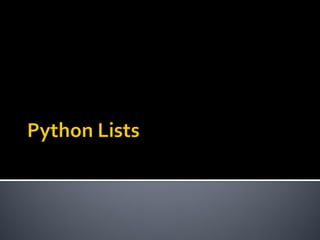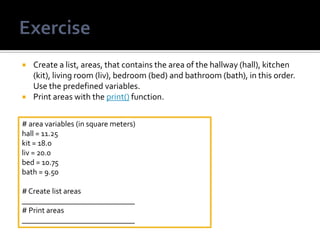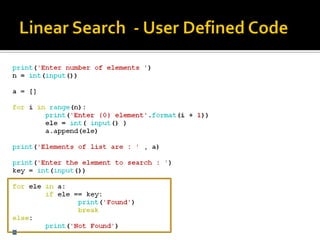Python list
- 2. Creating List Access, Modify and Delete list Elements Merge Lists Use the slicing syntax to operate on sublists Loop over lists
- 3. A list is a compound data type, you can group values together A list contains items separated by commas and enclosed within square brackets ([]). Lists are similar to arrays in C. One difference between them is that the items belonging to a list can be of different data type. The values stored in a list can be accessed using the [ ] operator Index starts at 0.
- 6. What is the result of this code? nums = [5, 4, 3, 2, 1] print(nums[-2])
- 7. >>> math = 45 >>> science = 23 >>> social = 28 >>> marksList = [math, science, social] >>> >>> print(marksList) [45, 23, 28]
- 8. Create a list, areas, that contains the area of the hallway (hall), kitchen (kit), living room (liv), bedroom (bed) and bathroom (bath), in this order. Use the predefined variables. Print areas with the print() function. # area variables (in square meters) hall = 11.25 kit = 18.0 liv = 20.0 bed = 10.75 bath = 9.50 # Create list areas _____________________________ # Print areas _____________________________
- 9. SN Function with Description 1 len(list) Gives the total length of the list. 2 max(list) Returns item from the list with max value. 3 min(list) Returns item from the list with min value. 4. sum(list) Returns the sum of all elements of list
- 12. Two List can be combined using + operator. We cannot add a integer with list using +
- 13. Forming new lists with a repeating sequence using the multiplication operator: Create a list of 5 elements with initial value as 0
- 14. Insertion Append(ele) Add element at end of List Insert(index , ele) Add element at given index Extend( seq ) Appends all the elements of seq to list Deletion Pop(index) Delete element based on Index Remove(key) Delete element based on key Count(key) Returns the number of occurrences of key Index(key) Returns the index of key element Sort Sorts elements of List Reverse Reverses elements of list
- 15. We can add elements to list. To add one element, use append method. This adds an item to the end of an existing list. mylist = [] mylist.append(5) mylist.append(8) mylist.append(12) #prints [5,8,12] print(mylist)
- 18. Insert the elements in sorted order. Algorithm If list is empty, append element to list. If element is less than first element, insert front. Traverse till current element is less than element to insert or till end of list Insert the element.
- 19. We can add a series of elements using extend method or + operator.
- 20. a = [1,2,3] b = [4,5,6] Understand the difference between a.append(b) and a.extend(b)
- 21. To delete last element
- 22. To delete element at specific Index
- 23. Remove method takes the key element to delete and removes it if present.
- 29. In all the previous methods, we were not able to determine the index where the key element is present.
- 30. index() method finds the given element in a list and returns its position. If the same element is present more than once, index() method returns its smallest/first position. If not found, it raises a ValueError exception indicating the element is not in the list.
- 31. The index method finds the first occurrence of a list item and returns its index. If the item isn't in the list, it raises aValueError. letters = ['p', 'q', 'r', 's', 'p', 'u'] print(letters.index('r')) print(letters.index('p')) print(letters.index('z')) 2 0 ValueError: 'z' is not in list
- 34. The sort method can be used to sort the elements of list.
- 38. mylist = [5 , 8 , 12 , 20 , 25, 50] mylist[startIndex : endIndex]
- 40. Mylist[startIndex : endIndex : step] mylist = [5 , 8 , 12 , 20 , 25, 50] print('Full list elements' , mylist) print('printing alternate elements', mylist[ : : 2]) print('printing in reverse order ', mylist[ : : -1])
- 42. == operator is used to check if two list have same elements. is operator is used to check if two references refer to same list.
- 45. # area variables (in square meters) hall = 11.25 kit = 18.0 liv = 20.0 bed = 10.75 bath = 9.50 # house information as list of lists house = [["hallway", hall], ["kitchen", kit], ["living room", liv], ["bedroom",bed], ["bathroom",bath]] # Print out house print(house) print(house[0]) print(house[1][0]) [['hallway', 11.25], ['kitchen', 18.0], ['living room', 20.0], ['bedroom', 10.75], ['bathroom', 9.5]] ['hallway', 11.25] kitchen
- 46. BMI = weight/height2 height = [ 1.87, 1.87, 1.82, 1.91, 1.90, 1.85] weight = [81.65, 97.52, 95.25, 92.98, 86.18, 88.45] bmi = weight / (height ** 2)
- 47. BMI = weight/height2 height = [ 1.87, 1.87, 1.82, 1.91, 1.90, 1.85] weight = [81.65, 97.52, 95.25, 92.98, 86.18, 88.45] bmi = [] n = len(height) for i in range(0,n): bmi.append(weight[i] / (height[i] ** 2)) print (bmi)
- 48. Python List Convert a list of temperature values from celsius to fahrenheit
- 49. Given a list of elements, create a new list which has elements with one added to every element of old list. nums = [12, 8, 21, 3, 16] new_nums = [13, 9, 22, 4, 17]
- 50. Collapse for loops for building lists into a single line Components Iterable Iterator variable Output expression
- 53. Given a list of elements extract all the odd elements and place in new list.
- 55. Conditionals on the iterable [num ** 2 for num in range(10) if num % 2 == 0] Conditionals on the output expression [num ** 2 if num % 2 == 0 else 0 for num in range(10)]
- 56. The all() function returns True if all elements of the supplied iterable are true or if there are no elements. So if all elements in a list, tuple, or set match Python's definition of being true, then all() returns True.
- 57. The any() function is the converse of the all() function. any() returns True if any element of the iterable evaluates true. If the iterable is empty, the function returns False
- 58. Read the marks of subject and find the result. Print Pass if marks scored in all the subjects is >= 35 otherwise Fail.
- 59. The zip() function take iterables, makes iterator that aggregates elements based on the iterables passed, and returns an iterator of tuples.


![ A list is a compound data type, you can group values
together
A list contains items separated by commas and enclosed
within square brackets ([]).
Lists are similar to arrays in C.
One difference between them is that the items belonging
to a list can be of different data type.
The values stored in a list can be accessed using the [ ]
operator
Index starts at 0.](https://image.slidesharecdn.com/pythonlist-190211124701/85/Python-list-3-320.jpg)


![ What is the result of this code?
nums = [5, 4, 3, 2, 1]
print(nums[-2])](https://image.slidesharecdn.com/pythonlist-190211124701/85/Python-list-6-320.jpg)
![>>> math = 45
>>> science = 23
>>> social = 28
>>> marksList = [math, science, social]
>>>
>>> print(marksList)
[45, 23, 28]](https://image.slidesharecdn.com/pythonlist-190211124701/85/Python-list-7-320.jpg)







![ We can add elements to list.
To add one element, use append method.
This adds an item to the end of an existing list.
mylist = []
mylist.append(5)
mylist.append(8)
mylist.append(12)
#prints [5,8,12]
print(mylist)](https://image.slidesharecdn.com/pythonlist-190211124701/85/Python-list-15-320.jpg)




![ a = [1,2,3]
b = [4,5,6]
Understand the difference between
a.append(b) and
a.extend(b)](https://image.slidesharecdn.com/pythonlist-190211124701/85/Python-list-20-320.jpg)










![ The index method finds the first occurrence of a list item and
returns its index.
If the item isn't in the list, it raises aValueError.
letters = ['p', 'q', 'r', 's', 'p', 'u']
print(letters.index('r'))
print(letters.index('p'))
print(letters.index('z'))
2
0
ValueError: 'z' is not in list](https://image.slidesharecdn.com/pythonlist-190211124701/85/Python-list-31-320.jpg)






![ mylist = [5 , 8 , 12 , 20 , 25, 50]
mylist[startIndex : endIndex]](https://image.slidesharecdn.com/pythonlist-190211124701/85/Python-list-38-320.jpg)

![ Mylist[startIndex : endIndex : step]
mylist = [5 , 8 , 12 , 20 , 25, 50]
print('Full list elements' , mylist)
print('printing alternate elements', mylist[ : : 2])
print('printing in reverse order ', mylist[ : : -1])](https://image.slidesharecdn.com/pythonlist-190211124701/85/Python-list-40-320.jpg)




![ # area variables (in square meters)
hall = 11.25
kit = 18.0
liv = 20.0
bed = 10.75
bath = 9.50
# house information as list of lists
house = [["hallway", hall],
["kitchen", kit],
["living room", liv],
["bedroom",bed],
["bathroom",bath]]
# Print out house
print(house)
print(house[0])
print(house[1][0]) [['hallway', 11.25], ['kitchen', 18.0], ['living room', 20.0], ['bedroom', 10.75], ['bathroom', 9.5]]
['hallway', 11.25]
kitchen](https://image.slidesharecdn.com/pythonlist-190211124701/85/Python-list-45-320.jpg)
![ BMI = weight/height2
height = [ 1.87, 1.87, 1.82, 1.91, 1.90, 1.85]
weight = [81.65, 97.52, 95.25, 92.98, 86.18, 88.45]
bmi = weight / (height ** 2)](https://image.slidesharecdn.com/pythonlist-190211124701/85/Python-list-46-320.jpg)
![ BMI = weight/height2
height = [ 1.87, 1.87, 1.82, 1.91, 1.90, 1.85]
weight = [81.65, 97.52, 95.25, 92.98, 86.18, 88.45]
bmi = []
n = len(height)
for i in range(0,n):
bmi.append(weight[i] / (height[i] ** 2))
print (bmi)](https://image.slidesharecdn.com/pythonlist-190211124701/85/Python-list-47-320.jpg)

![ Given a list of elements, create a new list which
has elements with one added to every element
of old list.
nums = [12, 8, 21, 3, 16]
new_nums = [13, 9, 22, 4, 17]](https://image.slidesharecdn.com/pythonlist-190211124701/85/Python-list-49-320.jpg)





![ Conditionals on the iterable
[num ** 2 for num in range(10) if num % 2 == 0]
Conditionals on the output expression
[num ** 2 if num % 2 == 0 else 0 for num in
range(10)]](https://image.slidesharecdn.com/pythonlist-190211124701/85/Python-list-55-320.jpg)



